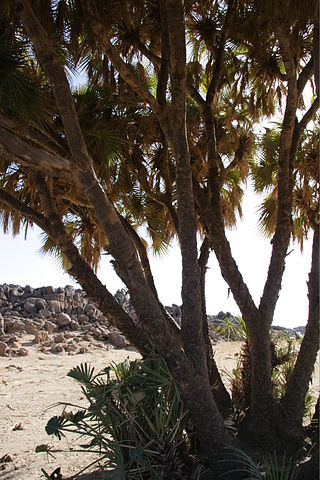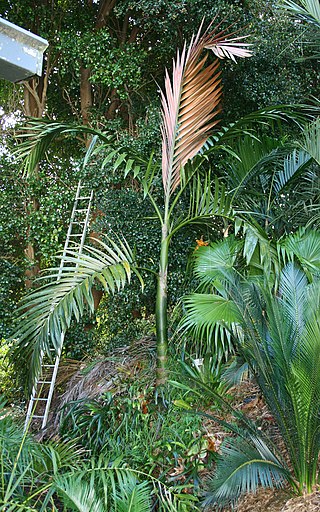
Cottan-Bimbang is a national park in New South Wales, Australia, 443 km north of Sydney and 65 km south east of Walcha and was formerly a state forest. The Oxley Highway crosses the park south of Werrikimbe National Park. Myrtle Scrub Road is a 15 kilometre circuit in the west of the park that connects with the Oxley Highway.

Hyphaene is a genus of palms native to Africa, Madagascar, the Middle East, and the Indian subcontinent.

The Ecdeiocoleaceae comprise a family of flowering plants with two genera and three species. The botanical name has rarely been recognized by taxonomists.

Arenga is a genus of palms, native to Southeast Asia, southern China, New Guinea, and northern Australia. They are small to medium-sized palms, growing to 2–20 m tall, with pinnate leaves 2–12 m long. Arenga palms can grow in areas with little sunlight and relatively infertile soil.

Pseudophoenix is a genus of palms which is native to the wider Caribbean. Three species of the four species are endemic to Hispaniola, while the fourth, P. sargentii, is widely distributed in the northern Caribbean, Florida, and the Yucatán Peninsula.

Archontophoenix is a plant genus comprising six palm species that are native to New South Wales and Queensland in eastern Australia. They are tall, slender and unbranched. Relationships between Archontophoenix and the other genera of subtribe Archontophoenicinae, including the New Caledonia endemic Actinokentia, Chambeyronia and Kentiopsis are unresolved.

Caryota is a genus of palm trees. They are often known as fishtail palms because of the shape of their leaves. There are about 13 species native to Asia, northern Australia, and the South Pacific. One of the more widely known species is Caryota urens, the flowers of which are used to make one type of jaggery, and also to make palm wine. Caryota mitis is native to Indochina, but has become an invasive introduced species in the US state of Florida. They are also one of the few Arecaceae with bipinnate foliage. Many grow in mountainous areas and are adapted to warm mediterranean climates as well as subtropical and tropical climates.

Chambeyronia is a genus of flowering plants in the family Arecaceae. It contains the following species, both endemic to New Caledonia: Relationships between Chambeyronia and the other genera of subtribe Archontophoenicinae, including the Australian Archontophoenix and the New Caledonia endemic Actinokentia and Kentiopsis are unresolved.

Cyphophoenix is a genus of flowering plant in the family Arecaceae. It contains 4 known species, all endemic to New Caledonia. The relationships between Cyphophoenix and some other genera of the tribe Basseliniinae including Physokentia and the New Caledonia endemic Burretiokentia are not clear.

Hyospathe is a genus of flowering plant in the family Arecaceae, native to South America and Central America. It contains the following species:

Latania, commonly known as latan palm or latania palm, is a genus of flowering plant in the palm tree family, native to the Mascarene Islands in the western Indian Ocean.

Linospadix is a genus of flowering plant in the family Arecaceae. It is native to New Guinea and Australia.

Neoveitchia is a genus of palm trees. It contains two known species, native to certain islands in the western Pacific:
Physokentia is a genus of flowering plant in the palm family, native to certain islands of the western Pacific.

Kerriodoxa elegans, the white backed palm, is the only species of palm tree in the genus Kerriodoxa, in the family Arecaceae.
Maxburretia is a genus of three rare species of palms found in southern Thailand and Peninsular Malaysia. The genus is named in honor of Max Burret, a German botanist.

Iriartella is a genus of two species of palms found in northern and northwestern South America. The Nukak people of Colombia use Iriartella setigera to fashion blowguns.
Clinosperma is a palm tree genus in the family Arecaceae.

Calyptrocalyx hollrungii is a palm species in the family Arecaceae, and is native to Papua New Guinea and to the Indonesian part of New Guinea, Western New Guinea.
Calyptrocalyx amoenus is a palm species in the family Arecaceae, and is native to Papua New Guinea and to the Indonesian part of New Guinea, Western New Guinea.
















